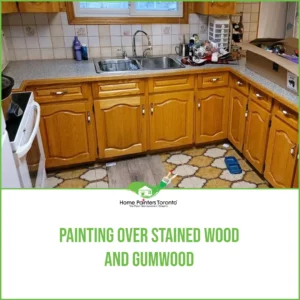
When it comes to home improvement and DIY projects, one question often arises whether you can paint over stained wood. The answer is yes, you can! However, there are a few essential steps to ensure the best possible result. In this blog, we’ll discuss the process of painting over stained wood, including the necessary preparation and the correct type of outdoor wood paint.
Painting over stained wood. It’s become both an exterior painting and interior painting conundrum. Individuals are often so puzzled about whether or not you can paint over stained wood (also known as gum wood). It seems that might be a no-no when it comes to a DIY painting project. But the thing is, if you do it the right way, painting over stained wood can work out quite nicely. You prepare yourself with the proper tools and materials to execute this project. And that’s why we’re here! So, without further adieu, let’s dig right into can you paint over stained wood?
Painting vs. Staining Wood: The Key Differences
Before diving into painting over stained wood, it’s important to understand the fundamental differences between painting and staining.
1. Appearance
The final appearance is one of the most noticeable differences between painting and staining wood. Paint provides a solid, opaque finish that covers the wood grain completely, allowing you to achieve a uniform colour and texture. On the other hand, stain penetrates the wood fibres, enhancing the natural grain pattern and adding colour without hiding the wood’s unique characteristics.
2. Protection
Both paint and stain protect wood surfaces, but they do so differently. Paint forms a protective barrier on the surface of the wood, shielding it from moisture, UV rays, and other environmental factors. Stain penetrates the wood fibres, providing protection from within while still allowing the wood to breathe. In general, paint offers a higher level of protection but may also be more prone to chipping and peeling over time.
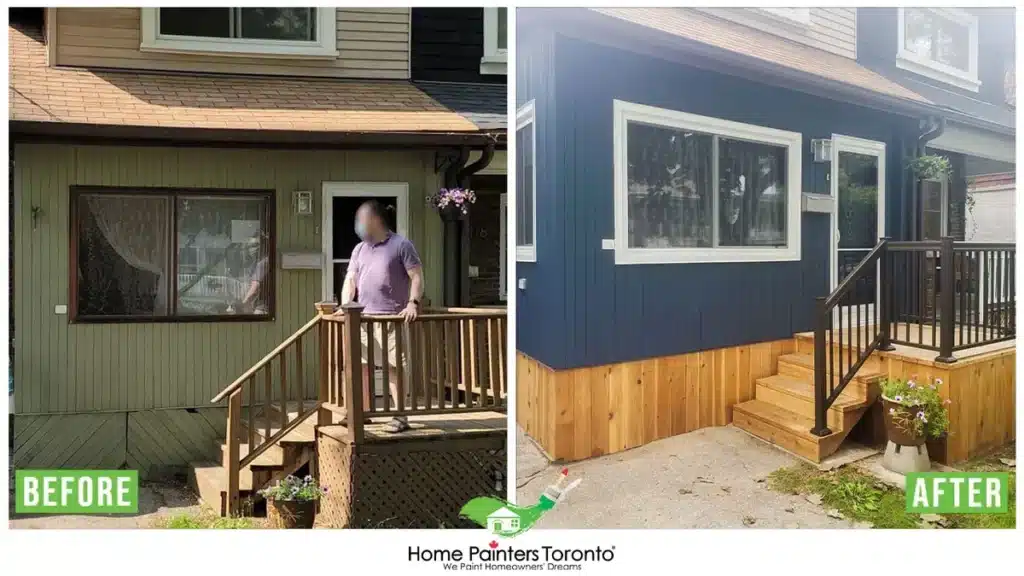
3. Maintenance
Maintenance requirements for painted and stained wood surfaces can vary. Painted wood typically requires frequent maintenance, as the paint can chip, peel, or crack over time. On the other hand, stained wood tends to require less maintenance, as the stain penetrates the wood fibres and is less prone to surface damage.
4. Application
The application process for paint and stain is also different. Painting requires a clean, dry, and well-prepared surface, as well as the use of a primer to ensure proper adhesion. Staining wood, however, does not always require a primer, and the application process is generally more straightforward.
Why Would You Want to Paint Over Stained Wood?
There could be several reasons why you might want to paint over stained wood. Perhaps the current stain colour doesn’t match your desired aesthetic, or the wood has become damaged or discoloured over time. Painting over the stain can give your wood a fresh, updated look while protecting it from further damage.
Preparing the Stained Wood for Painting
Before you start painting, properly preparing the stained wood surface is crucial. This will ensure that the paint adheres well and lasts long.
Prep is essential for painting over stained wood.
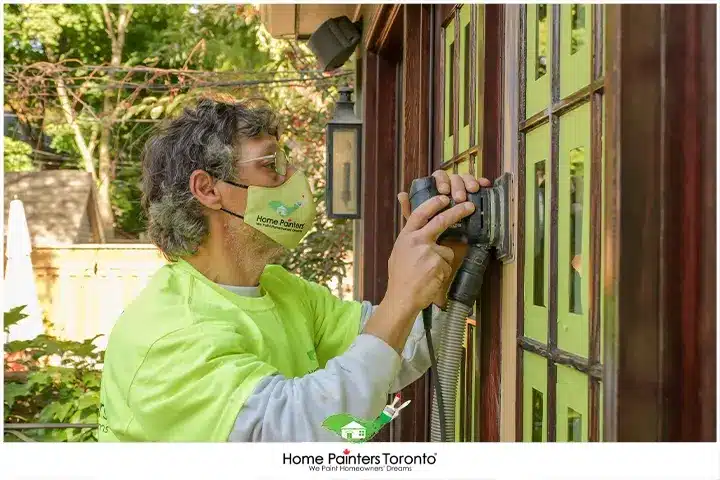
As with any DIY project, it’s best to research before beginning to ensure things go smoothly. The big issue with skipping over the prep when painting over stained wood is that if it’s not prepped sufficiently, tannins from the stain can bleed through the fresh paint. So, this is where you want to familiarize yourself with the stain before painting.
Any decent wood stain doesn’t just stick to the surface. It, it sinks into the grain itself,, changing the hue. You can usually determine the type of stain used on the wood in question simply by testing it. If you sprinkle some water over the wood and it beads up after a moment, it is stained with an oil-based stain. Painting over oil-based stained wood is a bit of a different process. But don’t worry. We’ll catch you up too!
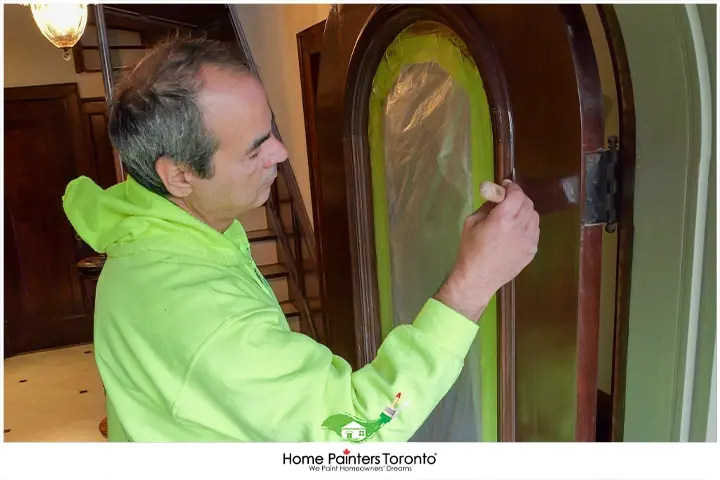
Choosing the Right Paint for Stained Wood
What type of paint to use over stained wood?
When selecting paint for your stained wood project, choosing high-quality wood paint will provide excellent coverage, and durability is essential. Oil-based paints are popular for painting over stained wood, as they offer excellent adhesion and a smooth finish. However, they do have a strong odour and longer drying times.
Alternatively, you can use high-quality latex paint, which is easier to work with and has lower VOCs (volatile organic compounds). If you choose latex paint, be sure to use a latex primer as well.
Painting vs. Staining Wood: The Key Differences
Painting Over Stained Wood
Wondering how to paint over stained wood? There are a few steps you want to take before starting your painting. We’ll break it down step-by-step for you.
• Firstly, you want to give the wood surface — a deck, fence, table, staircase or piece of furniture, a good cleaning. Use soapy water to remove any dirt, dust or grim.
• Then, you’ll want to work to dull the stain. This step involves getting out your sandpaper (about 150 grit) and lightly sanding in the direction of the grain. Brush away any excess dust.
• The next step to prepare for painting over stained wood is to use a deglosser or liquid sander. Deglosser works to dull an old finish. If the wood is super rough, irregular, pitted or scratched, using only deglosser won’t do the job properly. You need to go to town with your sanding if your stained wood is irregular. If it’s quite smooth and you want to dull the stained finish, put on your safety goggles and gloves and wipe down your wooden surface with a small amount of deglosser on a rag. Allow the deglosser to dry for 10 minutes before moving on.
• Once your deglosser is dry and you spot any major imperfections in the wood, you can go in with wood filler and sand down to make it smooth.
• Then, once you have completed all these steps, you can go in with your primer! Which is the last step before painting.
• You can apply two coats of your chosen interior or exterior paint colour from there. Be sure to do two coats for optimal coverage and to wait until the next day to apply your second coat.
Painting Over Stained Wood If It’s an Oil-based Stain
Can you paint over oil-stained wood?
The process is slightly different when you want to cover an oil-based stain with paint.
Before the priming and painting, there is additional prep work required. We’ll walk you through the final steps before painting over stained wood that was an oil-based stain:
- Of course, you want to have your protective goggles and gloves on and proper ventilation in the area you’re working in.
- Then you’ll want to dissolve a heavy-duty cleaner, like Trisodium Phosphate, into a gallon of warm water. How trisodium phosphate works is that it’s an inorganic compound which produces an alkaline solution when dissolved in water. It works as a heavy-duty cleaner and stain remover. So, using the trisodium phosphate will help to get in there and penetrate that oil-based stain before painting.
- You can dip a sponge or rag into the solution and cleanse the surface of your wood. Repeat this process if you want the best results.
- • Then, you can sand all rough areas of the wood and be sure to wipe it clean afterwards.
- When choosing a primer to paint over stained wood, it’s best to choose an oil-based primer. That way, you’ll be ensured that it will adhere better to glossy or previously stained surfaces.
- Once you’ve applied your primer, you can go in with your interior or exterior paint. Again, for optimal results, apply two coats.
Can You Paint Over Gum Wood?
Lastly, a lot of the time, when people are thinking about painting over stained wood, they often wonder if they can paint over gumwood as well. In case you aren’t aware, gumwood is simply a kind of wood used in cabinetry, panels, trim, furniture, and doors and is often used to make plywood. It can often be orange in colour, which many people grow tired of over time.
The answer is you can paint over gumwood. Follow the steps we’ve laid out: prep, sand, prime and then two coats of paint! It’s as easy as that, and you’ll find your stained or gumwood instantly revitalized and modernized.
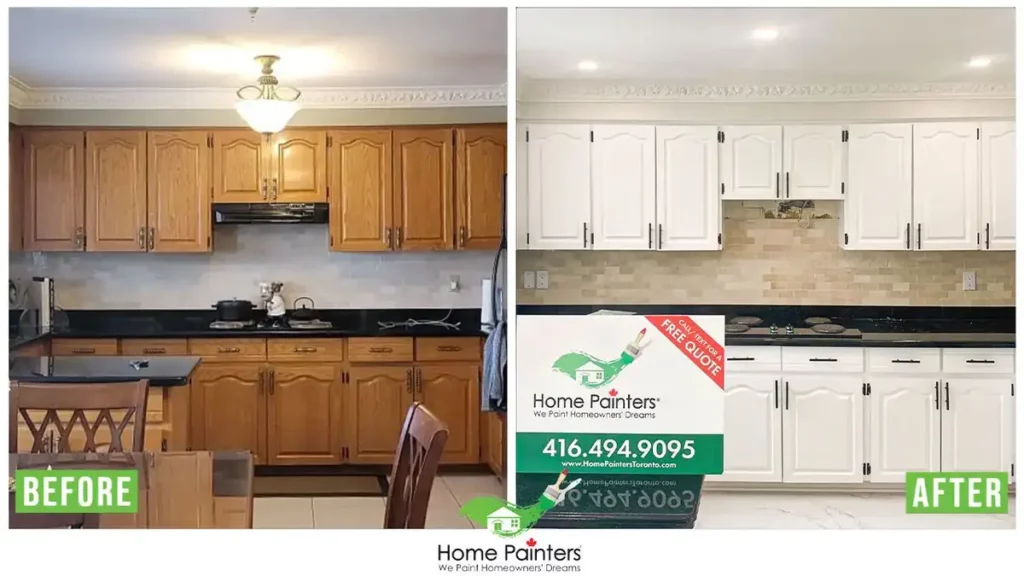
If you’re confused about picking out the right colour for your interior or exterior painting when it comes to painting over stained wood, allow us to help! White is enormous in terms of exterior painting trends if you’re painting a deck. Woodland White is an excellent place to start. Another great option for deck painting or fence painting is grey this season. Greyhound is a beautiful grey that’s not too light. Rich browns are all the rage as well if you’re painting wood. Check out Butternut Brown for a rich and bold brown.
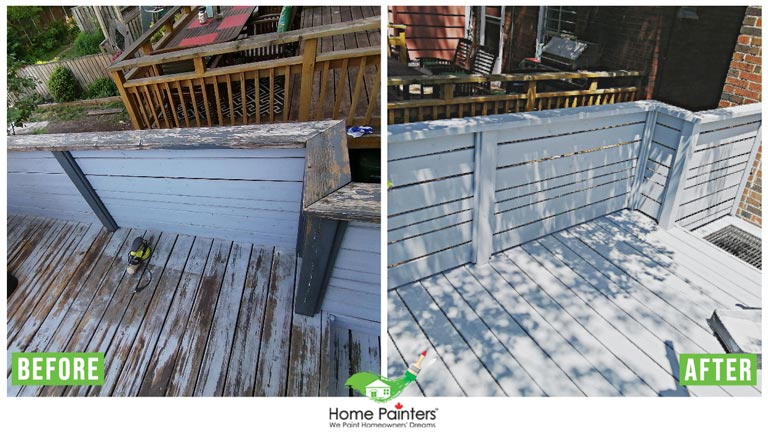
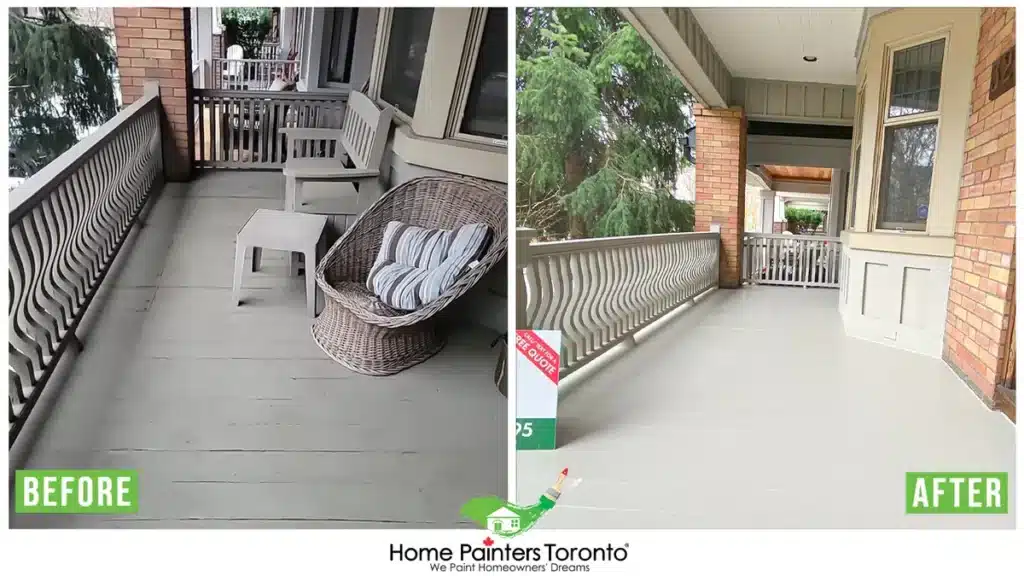
In conclusion…
Painting over stained wood is possible and can yield beautiful results. This is what happens if you paint over stained wood when done correctly. By properly preparing the surface, choosing the right paint and primer, and following the necessary steps, you can give your stained wood a fresh, updated look that will last for years.
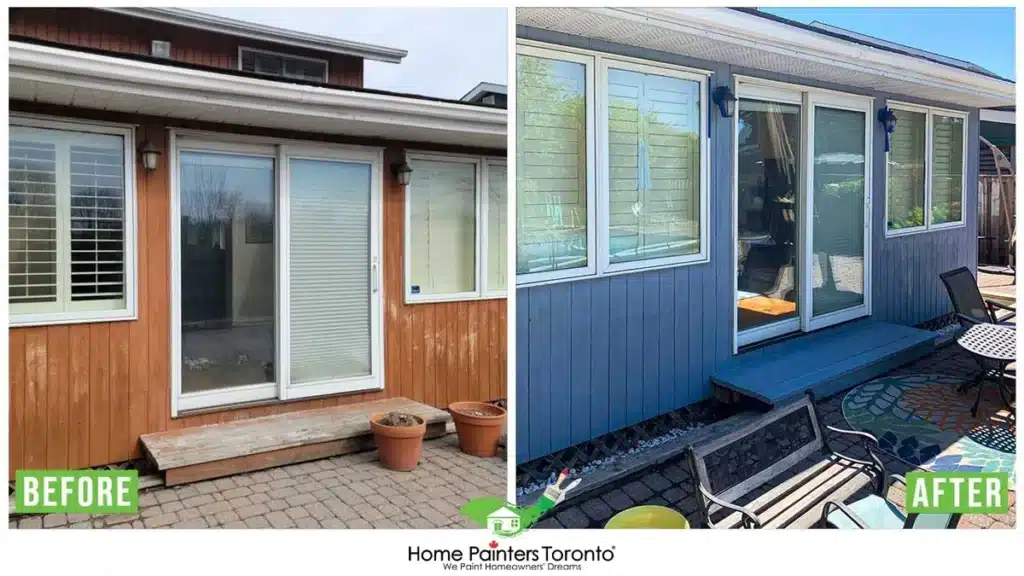
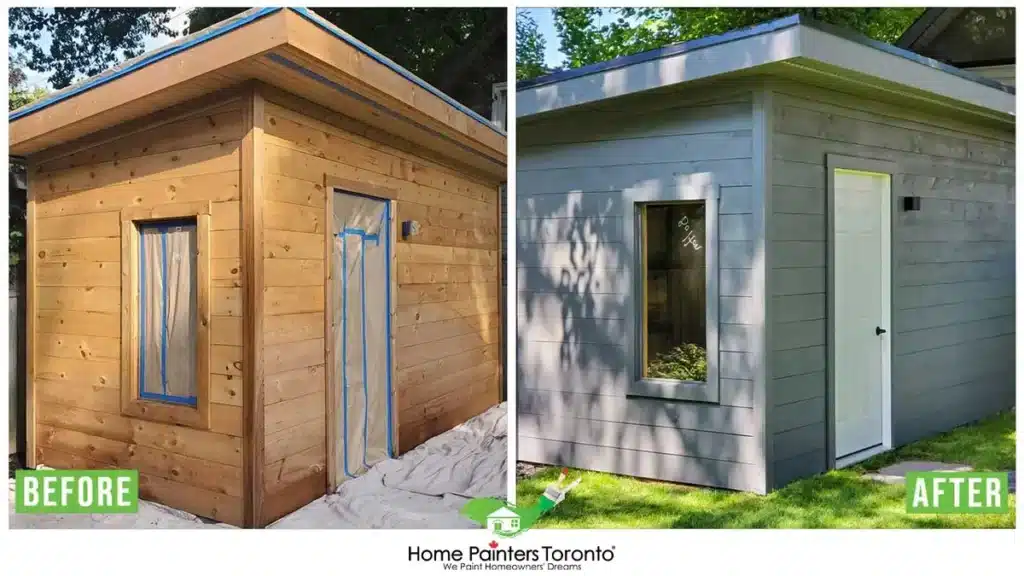
TOP Blogs Related to
“CAN YOU PAINT OVER STAINED WOOD?”
Want someone else to handle all the interior painting or exterior painting work for you? It sounds like you might be looking for some tried and true professional painters to get you through! Give us a call at 416.494.9095 or email Brian@HomePaintersToronto.com for a FREE quote. And don’t forget to follow us on all our social channels below!




